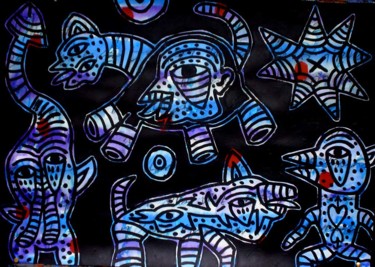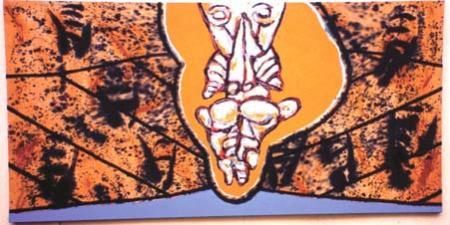J Castilla-Bambaren
Jorge Castilla-Bambarén es un importante artista peruano que ha expuesto sus pinturas en las siguientes Bienales Internacionales: 1991 XXI Bienal de Sao Paulo, Brasil; 1994 V Bienal de La Habana, Cuba; 1989 II Bienal de Cuenca, Ecuador y en 1992, la VIII Bienal Iberoamericana de México.
En Perú ha realizado periódicamente numerosas presentaciones personales desde 1981. La pintura de Jorge Castilla-Bambarén es figurativa, reúne elementos de abstracción y geometría. Su personal estilo de pintura se nutrió de varias fuentes, las más evidentes son: el expresionismo alemán, el arte prehispánico del Perú y América Latina, el “Art Brut”, el arte africano y el oceánico.
Las estructuras compositivas de sus pinturas también muestran una interesante asimilación del lenguaje artístico de la abstracción y la informalidad, acompañada de líneas y pinceladas que permiten reconocer la presencia del “Raw Art” como una dimensión más de influencia en su proceso creativo. forma de expresión que podría denominarse síntesis de lenguajes racionales con expresiones primitivas.
-------------------------------------------------< br />
Alquimia
Jorge Castilla-Bambaren ha integrado en sus pinturas diversos elementos figurativos que son la suma de formas orgánicas, volúmenes abstractos y geométricos, acompañados de paisajes y espacios naturales de carácter mágico.
Ciertas obras dan la impresión de que se desarrollan en el interior de atmósferas en ebullición, colores del magma volcánico de un mundo en proceso de formación; Las figuras llegan en transparencia, lo que nos permite ver el fondo, dando así un diálogo de los planos en interacción con la composición.
Al dibujar a sus personajes, el artista utiliza el negro sobre fondos de colores. Las entidades o figuras de su imaginación se moldean en estado de metamorfosis. Encontramos las diferentes características de diversos orígenes. Finalmente el conjunto se unifica en su aspecto antropomórfico.
Sus pinturas están compuestas por elementos gráficos vinculados al trazo y la representación de las culturas precolombinas, vinculados también a la cultura amazónica, petroglifos y graffitis urbanos. No olvidemos que el artista tuvo una etapa expresionista con alusiones a " máscaras de cabeza", también a los tótems de montaña. El cuerpo también estuvo representado. Todo se presenta de forma disruptiva mediante una extraña geometría de planos, colores, que sugieren un lenguaje minimalista o incluso abstracto.
Jorge Castilla-Bambaren crea un arte que nos pone en contacto con aspectos mágico-rituales poco conocidos, logrando su mezcla alquímica de diferentes ismos del arte. Es una pintura que sintetiza de manera creativa y personal las formas, las expresiones del arte brut, el arte naif, el arte crudo y el arte informal... un arte sutil que evoca el dibujo poético hecho con humo de vela.
Tamara da Costa
Brasil 2005
Descubra obras de arte contemporáneas de J Castilla-Bambaren, explore obras de arte recientes y compre en línea. Categorías: artistas peruanos contemporáneos. Dominios artísticos: Pintura. Tipo de cuenta: Artista , miembro desde el 2005 (País de origen Perú). Compre los últimos trabajos de J Castilla-Bambaren en ArtMajeur: J Castilla-Bambaren: Descubre impresionantes obras del artista contemporáneo. Explorar obras de arte, comprar obras originales o impresiones de alto nivel.

Valoración del artista, Biografía, Estudio del artista:
Todas las obras de J Castilla-Bambaren
j castilla bambaren • 92 obras de arte
Ver todoReconocimiento
Biografía
Jorge Castilla-Bambarén es un importante artista peruano que ha expuesto sus pinturas en las siguientes Bienales Internacionales: 1991 XXI Bienal de Sao Paulo, Brasil; 1994 V Bienal de La Habana, Cuba; 1989 II Bienal de Cuenca, Ecuador y en 1992, la VIII Bienal Iberoamericana de México.
En Perú ha realizado periódicamente numerosas presentaciones personales desde 1981. La pintura de Jorge Castilla-Bambarén es figurativa, reúne elementos de abstracción y geometría. Su personal estilo de pintura se nutrió de varias fuentes, las más evidentes son: el expresionismo alemán, el arte prehispánico del Perú y América Latina, el “Art Brut”, el arte africano y el oceánico.
Las estructuras compositivas de sus pinturas también muestran una interesante asimilación del lenguaje artístico de la abstracción y la informalidad, acompañada de líneas y pinceladas que permiten reconocer la presencia del “Raw Art” como una dimensión más de influencia en su proceso creativo. forma de expresión que podría denominarse síntesis de lenguajes racionales con expresiones primitivas.
-------------------------------------------------< br />
Alquimia
Jorge Castilla-Bambaren ha integrado en sus pinturas diversos elementos figurativos que son la suma de formas orgánicas, volúmenes abstractos y geométricos, acompañados de paisajes y espacios naturales de carácter mágico.
Ciertas obras dan la impresión de que se desarrollan en el interior de atmósferas en ebullición, colores del magma volcánico de un mundo en proceso de formación; Las figuras llegan en transparencia, lo que nos permite ver el fondo, dando así un diálogo de los planos en interacción con la composición.
Al dibujar a sus personajes, el artista utiliza el negro sobre fondos de colores. Las entidades o figuras de su imaginación se moldean en estado de metamorfosis. Encontramos las diferentes características de diversos orígenes. Finalmente el conjunto se unifica en su aspecto antropomórfico.
Sus pinturas están compuestas por elementos gráficos vinculados al trazo y la representación de las culturas precolombinas, vinculados también a la cultura amazónica, petroglifos y graffitis urbanos. No olvidemos que el artista tuvo una etapa expresionista con alusiones a " máscaras de cabeza", también a los tótems de montaña. El cuerpo también estuvo representado. Todo se presenta de forma disruptiva mediante una extraña geometría de planos, colores, que sugieren un lenguaje minimalista o incluso abstracto.
Jorge Castilla-Bambaren crea un arte que nos pone en contacto con aspectos mágico-rituales poco conocidos, logrando su mezcla alquímica de diferentes ismos del arte. Es una pintura que sintetiza de manera creativa y personal las formas, las expresiones del arte brut, el arte naif, el arte crudo y el arte informal... un arte sutil que evoca el dibujo poético hecho con humo de vela.
Tamara da Costa
Brasil 2005
-
Nacionalidad:
PERÚ

- Fecha de nacimiento : fecha desconocida
- Dominios artísticos:
- Grupos: Artistas Peruanos Contemporáneos
Eventos artísticos actuales y próximos
Influencias
Formación
Cotización de artista certificada
Logros
Actividad en ArtMajeur
Últimas noticias
Todas las últimas noticias del artista contemporáneo J Castilla-Bambaren
JCB UNA OBRA CONTRA LA CORRIENTE
UNA OBRA CONTRA LA CORRIENTE
La trayectoria de Jorge Castilla-Bambarén desde que empezó a pintar es un ir contra la corriente. Los resultados están a la vista, una obra original e intensa que no se aviene a las banalidades de la moda ni a los dictados de la mercadotecnia.
Esta distancia que el propio Castilla-Bambarén marcó desde temprano, no le ha impedido ser reconocido como uno de los principales exponentes de la plástica peruana. Su participación en importantes bienales como las de Sao Paulo, de La Habana .la de Cuenca y la Iberoamericana de México ,el cortometraje “serie negra” del cineasta Nelson Garcia de 1990 son pruebas más que suficientes de su innegable calidad y trascendencia.
Desde muy joven , JCB mostró particular interés por las pinturas de los alienados del Hospital Larco Herrera (*). Desde entonces, con espíritu selectivo, pudo apreciar la fuerza expresiva del llamado Arte Bruto (Art Brut) que bien comprendido abarca también las creaciones de todos aquellos artistas que no son considerados como tales porque no se ubican en los estrechos confines de la academia.
Esta amplitud de miras no es ajena a su sólida formación pictórica. Hace veinticinco años, nuestro gran artista David Herkovitz escribió: “Yo admiro las pinturas de Jorge Castilla-Bambarén, en primer lugar porque demuestran un obvio dominio sobre los distintos aspectos de lo pictórico: color, dibujo, expresión, espacio, línea y composición.” A las palabras del maestro Herkovitz habría que añadir que Jorge es un hombre de cultura en el sentido pleno de la palabra. Sus intereses y conocimientos no se limitan a las artes plásticas, se extienden con manifiesto placer a la música, literatura, fotografía, antropología, cine, teatro y danza. Una formación integral a la que todo artista debería aspirar.
La pintura de Castilla-Bambarén ha permanecido fiel a sí misma, lo cual no quiere decir inmutable. Todo lo contrario, es una obra permeable a las corrientes innovadoras de la vanguardia y que además ha tenido la audacia y la sensibilidad suficientes para incorporar a su pintura las manifestaciones creativas y singulares de los pueblos olvidados e ignorados por la cultura oficial. Respecto a esto último es útil recordar lo que escribiera en el 2008 el gran crítico y artista argentino Luis Felipe Noé sobre la pintura de JCB: “Él nos revela las presencias que nacen de su mano de pintor, de las cuales es el primer contemplador. Vienen del caos creador -lo que Gilles Deleuze define como “caos–germen”- y quedan así fijadas inmóviles ante nosotros (un nosotros que lo incluye a Castilla-Bambaren) como si fuesen eternas. Con fuerza y precisión, él las define como si viniesen de un cuento para niños, pero para esos infantes que lo somos todos, más allá de las edades. Estas presencias ominosas, amenazantes, él nos las presenta como si fuesen mascotas, ya que a lo largo de su vida ha ido tomando confianza con ellas. Su salvajismo es su dignidad de artista. Castilla-Bambaren se ubica frente al mundo como un primitivo, sintiendo que este lo excede. Pero en este caso, el “exceso de objeto”, del que habla Levi Strauss, es más cultural que natural.”
Entre los que aprecian su obra, están los que encomian principalmente las tonalidades que van del negro al blanco, pasando por el gris. Incluso los partidarios de una paleta polícroma no dejan de sentir admiración por su mítica “serie negra” o por su obra en blanco y negro de los finales de los ochenta y comienzos de los noventa. Cómo olvidar esas imágenes poderosas, esos demonios que algunos consideran como expresiones del horror o de lo trágico.
Por supuesto que no faltan los entusiastas de los colores encendidos, los que prefieren, con indisimulada excitación, su manejo desenfadado del color que hace más patente las alucinantes escenas de sus cuadros.
De ambas apreciaciones se colige un universo cromático lo suficientemente rico y variado para todos los gustos y que él lo usa con pleno dominio de acuerdo a lo que desea expresar en cada una de sus pinturas.
Por otro lado, el particular bestiario de Castilla-Bambarén está conformado por seres inquietantes que parecen emerger del fondo de la noche o del subsuelo inmemorial para pertubar a las buenas conciencias. Sin embargo, no todas sus pinturas buscan la confrontación ni están destinadas a incomodar al burgués ni a develar su doble moral. No todos sus personajes son seres desaforados con lenguas como flechas que apuntan directamente al corazón. No todos son bestias insolentes que exhiben sin pudicia falos y vaginas que se unen en alegre bacanal. Hay otras pinturas de intenso colorido con figuras totémicas o formas bellamente delineadas que evocan ritos ancestrales o escenas que recuerdan, en el sentido de Goya, los sueños de la razón.
La pintura de JCB es más compleja y variada de lo que mucha gente supone. Tiene varios registros. Un lado lúdico que por temor al ridículo es ignorado por doctos y solemnes; una serena inteligencia que asume como propias las formas más primitivas del arte de África, de Oceanía o de América con libertad, profundidad y originalidad.
Cómo no coincidir una vez más con el maestro Luis Felipe Noé cuando afirma que “Castilla-Bambaren pertenece al grupo selecto de artistas que contribuyen a imaginar a América Latina”.
Lorenzo Osores
Lima Peru 2015
(*) Larco Herrera hospital psiquiatrico de Lima fundado el 1 de enero de 1918
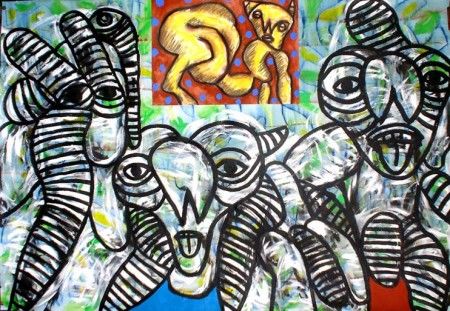
J CASTILLA-BAMBAREN STATEMENT
…" SINCE MY EARLY CHILHOOD I WAS SEDUCED BY THE BEAUTY AND EXPRESSION OF THE PERUVIAN PRE-COLUMBIAN POTTERY,TEXTILES,AND SCULPTURES. LATER I DISCOVERED THE ARTISTIC EXPRESSIONS OF OTHER LATIN AMERICAN CULTURES THE MAYAS,OLMECS.AZTECS,ETC. SINCE I STARTED TO PAINT AND DRAW I HAD A EMOTIONAL CONNECTION WITH SURREALISM AND GERMAN EXPRESSIONIST PAINTING . I ALSO FELL IN LOVE WITH THE CULTURES OF AFRICA AND OCEANIA , AND WITH THE MARVELOUS ART BRUT ,RAW ART ,AND THE PRIMITIVE DRAWINGS MADE BY CHILDREN… WHEN I START TO PAINT AND DRAW I PUT MYSELF NATURALLY IN A SORT OF ,
-JAZZ IMPROVISATIONAL MOOD - I HAVE NO PRECONCIEVED IDEA OF WHAT IS GOING TO BE CREATED BY MY HANDS AND WHEN IT ALL FINISHES I AM THE FIRST TO BE SURPRISED OF WHAT APPEARED IN MY CANVAS OR PAPER…"
J.CASTILLA-BAMBAREN 2003 - LIMA PERU
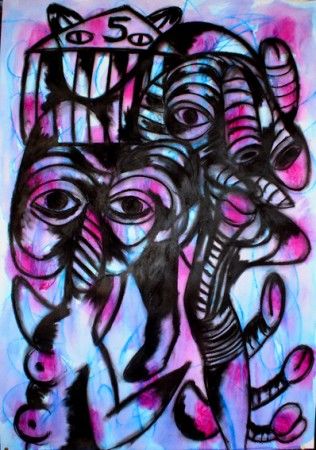
J CASTILLA-BAMBAREN
Jorge Castilla Bambaren ist ein peruanischer Künstler, der seine Werke in folgenden internationalen Biennalen ausgestellt hat:
1991, XXI Biennal von Sao Paulo – Brasilien, 1994, V Biennal von La Habana – Kuba, 1989, II Biennal von Cuenca – Ekuador und 1992, VIII Iberoamerikanische Biennal von Mexiko. In Peru wurde sein Werk seit 1989 auf periodischen Einzelausstellungen gezeigt.
Die Bilder von Jorge Castilla Bambaren sind figurativ und vereinigen Elemente des Abstrakten und der Geometrie. Sein eigener Stil stammt aus verschiedenen Quellen, die sichtbarsten davon sind wohl: Der deutsche Expressionismus, die vorspanische Kunst aus Peru und Lateinamerika, „Art Brut“ und die afrikanische und ozeanische Kunst.
Die Strukturen der Komposition seiner Bilder zeigen eine interessante Angleichung der künstlerischen Sprache der Abstraktion und der informellen Kunst, die mit einer Darstellung und Pinselstrich, welche die Präsens des „Raw Art“ als einen weiteren Strom von Einflüssen in seinem kreativen Prozess erkennen lassen. Die seinige ist eine Ausdrucksweise, die wir als Synthese von rationellen Sprachen des primitiven Expressionismus bezeichnen können.
Aussagen zu seinem Werk:
Castilla Bambaren gehört zur ausgesuchten Gruppe von Künstlern, die helfen, sich Lateinamerika vorzustellen.
Luis Felipe Noe – Künstler
Mit einer einfachen Gestaltung der Zeichnung, seltener Komposition- und Erfindungsgabe und einer ungezwungenen Handhabung der Farbe, welche klingende Begeisterung sucht, um die verblendeten Szenen mehr sichtbar zu machen.
Alfonso Castrillon
Historiker
Ich bewundere die Bilder von J. Castilla Bambaren, zuerst weil sie eine unverkennbare Beherrschung der verschiedenen Aspekte des Malens aufweisen: Farbe, Zeichnung, Aussage, Raum, Strich und Komposition.
David Herzkovitz – Künstler
Dort sattelt die Kraft des Werkes von JCB - einschneidend, schmerzhaft, heftig und eindringlich - , seine Ehrlichkeit, verbunden mit Einfachheit der Linien und Farben und mit der Präferenz einer gleichzeitigen dialektischen Gegenüberstellung farblicher Spielereien, eingesetzt mit derselben Kraft der Heftigkeit, die sie darstellen.
Mariano Querol – Psychiater
Die Annäherung zur Malerei von Castilla Bambaren bedeutet einzudringen in ein Gebiet seltsamer Kräfte. Es handelt sich um ein eklektisches Werk, welches durch die Einzigartigkeit des Blicks des Künstlers einen bewundernswerten Zusammenhalt und Einheit erreicht.
Jorge Villacorta – Kurator
Die letzten Bilder von Castilla Bambaren sind die Bestätigung einer ganz persönlichen und einsamen „Schule“. Bestimmt durch die Kraft der Farbe und der gegenüberstellenden Aussage der aktiven Gegenständlichkeit, bewegen sich seine Themen in starker Übereinstimmung mit einer bildlichen Sprache.
Silvio de Ferrari – Historiker
Eines ist gewiss, es gibt Künstler, die sich weit entfernt von einer jeglichen Einordnung befinden, da ihre Vorschläge weiter als nur das bereits bekannte gehen und sie schaffen sich eigene Weltbilder; so wie der peruanische Maler J. Castilla Bambaren, welcher eine Metamorphose vorschlägt, die sich in Form von Katharsis verbildlicht oder auflöst.
Luisa Fernanda Lindo – Kuratorin und Dichterin
J. Castilla Bambaren bleibt ein Maler, befremdender Weise allein unter seinesgleichen, aber des Kultes für einige junge peruanische Maler, immer aufmerksam gegenüber seinem persönlichen Bestiarium und seinem Mut der Komposition in dem Umfeld der Entstehung.
Manuel Munive – Historiker und Kurator
Die Malerei von JCB ist komplexer und mannigfaltiger als viele es sehen, sie enthält verschiedene Nuancen, eine spielerische Seite, welche aus Angst vor Lächerlichkeit von Weisen und Pompösen ignoriert wird; eine überquellende expressive Kraft, eine ruhige Intelligenz, die sich mehr die primitiven Formen der Kunst aus Afrika, Ozeanien und Amerika mit Freiheit, Tiefe und Originalität zu eigen macht.
Lorenzo Osores – Schriftsteller und Künstler

JCB Die Kunst der Metamorphose
Die Kunst der Metamorphose
Jorge Castilla Bambaren ist ein anerkannter, peruanischer Künstler, der an folgenden internationalen Biennalen teilnahm: 1191 – XXI. Biennale von Sao Paulo – Brasilien, 1994 – V. Iberoamerikanische Biennale von La Habana – Kuba, 1989. – II Biennale von Cuenca – Ekuador und in 1992 – VIII Interamerikanische Biennale von Mexiko. In Perú periodische Einzelausstellungen ab 1981. Die figurativen Bilder von Jorge Castilla Bambaren vereinen in sich abstrakte sowie geometrische Elemente. Sein persönlicher Stil schöpft aus verschiedenen Quellen, hier vielleicht sind die erkennbarsten: Der Deutsche Expressionismus, die Präkolumbinische Kunst Perus und Lateinamerikas, Art Brut und die Kunst Afrikas und Ozeaniens. Seine Komposition der Strukturen zeigen auch eine interessante Nähe zur Ausdruckweise des Abstrakten und dem Informalismus, dieses vereint mit einer Zeichnung bzw. Pinselführung, welches das Vorhandensein des Raw Art als weiteren Zug eines Einflusses zu seinem kreativen Werk erkennen lässt. Das Seinige ist eine Form des Ausdrucks, den wir al seine Synthese eines Rationalismus mit primitiven Anschauungen benennen könnten.
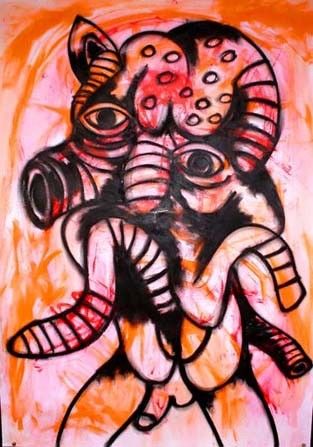
J CASTILLA-BAMBAREN ALCHEMY
ALCHEMY
In his paintings, Castilla-Bambarén has integrated several figurative elements adding organic shapes and abstract-geometric volumes with landscapes and spaces of magical nature.
Some of these works seem to develop in an atmosphere of sizzling colors, the volcanic magma of a world in formation; also in his paintings, figures are rendered in transparency, allowing us to see the background, in the manner of a compositional dialogue of planes.
When drawing his characters, the artist uses black over a color background, the entities or his invented figures are depicted in a state of metamorphosis and in them we find characteristics of different origin, finally all coming together as anthropomorphic.
His paintings are composed of graphic elements that are linkable to the linearity of the design of pre-Columbian and indigenous-jungle cultures, petroglyphs and urban graffiti.
We must also note that in some works the artist has painted expressionist masses and volumes resembling a head-mask, and allusions to the body, the mountain totem. All this, disturbingly balanced by a strange geometry of color planes, which also show his assimilation of the abstract-minimalist language.
Castilla-Bambaren has created an art that relates us to unknown magical rituals aspects, with works where the artist achieves the alchemical mixture of various isms of art.
In his paintings, JCB synthesizes in a creative and very personal manner the expressive forms of art brut, children's art, raw art and the best of informal art ...his art is like the subtle poetry of drawing with candle smoke...
Tamara da Costa
Brazil 2005
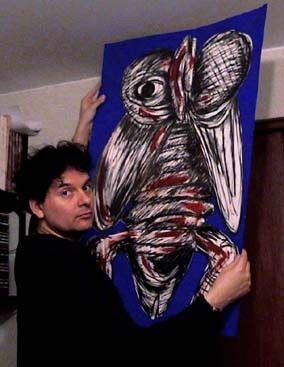
J CASTILLA-BAMBAREN A WORK AGAINST THE GRAIN
A WORK AGAINST THE GRAIN
Since he began painting, Jorge Castilla-Bambarén has followed his path by going against the grain. The results are obvious, an original and intense work that does not agree to the banalities of fashion or the dictates of marketing.
This distance that Castilla-Bambarén himself put early on has not prevented him from being recognized as one of the leading exponents of Peruvian art. His participation in important biennials such as that of Sao Paulo, Havana, Cuenca and Mexico's Ibero-American Biennial, and the short film "Black Series" by filmmaker Nelson García (1990), are more than enough proof of his undeniable quality and significance.
From a young age (1980), JCB was particularly interested in the paintings of the psychiatric patients at Larco Herrera Hospital (*). Since then, with selective spirit, he could appreciate the expressive force of so called Art Brut, which, well understood, also encompasses the creations of all those artists who are not considered as such because they do not fall within the narrow confines of academia.
This breadth of vision is not alien to his strong artistic training. Twenty five years ago, our great artist, David Herkovitz, wrote: "I admire the paintings of Jorge Castilla-Bambarén, first because they show an obvious mastery over the various aspects of painting: color, drawing, expression, space, line and composition." To Herkovitz's words, it should be added that Jorge is a man of culture in the full sense of the word. His interests and knowledge are not limited to the visual arts; they extend, with overt pleasure, to music, literature, photography, anthropology, cinema, theater and dance. A comprehensive training that every artist should aspire to have.
The painting of Castilla-Bambarén has remained true to itself, which does not mean immutable. On the contrary, it is a work permeable to innovative currents of the avant-garde and which has been bold and sensitive enough to incorporate into painting the creative and unique manifestations of peoples forgotten and ignored by the official culture. Regarding the latter, it is useful to recall what the great Argentine critic and artist, Luis Felipe Noé, wrote in 2008 about JCB’s painting: “He reveals us the presences born from his painter’s hand, of which he is the first beholder. They come from the creative chaos—what Gilles Deleuze defines as ‘chaos-germ’—and are thus laid motionless before us (an ‘us’ that includes Castilla-Bambaren), as if they were eternal. With force and precision, he defines them as if they came from a children's story, but for the children beyond all ages that we all are. He presents these ominous, threatening presences as if they were pets, for throughout his life he has built trust with them. His savagery is the dignity of the artist. Castilla-Bambaren faces the world as a primitive, feeling that it exceeds him. But in this case, the ‘excess of object,’ mentioned by Levi Strauss, is more cultural than natural.”
Among those who appreciate his work, are those who mainly commend the hues, which range from black to white, through gray. Even supporters of a polychrome palette feel admiration for his legendary “Black Series” or for his work in black and white from the late eighties and early nineties. How could one forget those powerful images, those demons which some regard as expressions of horror or tragedy!
Of course there is no shortage of bright-color enthusiasts, who prefer, with undisguised excitement, his bold use of color, which makes the amazing scenes in his paintings more obvious.
From both assessments, a chromatic universe rich and varied enough for all tastes can be inferred, which he uses with complete mastery according to what he wishes to express in each of his paintings.
Furthermore, the particular bestiary of Castilla-Bambarén consists of disturbing beings that seem to emerge from the depths of the night or the immemorial underground to disturb the good consciences. However, not all his paintings seek to confront nor are intended to shock the bourgeoisie, nor reveal its double standards. Not all of Castilla-Bambarén’s characters are outrageous beings with tongues like arrows pointing straight to the heart. Not all are insolent beasts shamelessly displaying phalluses and vaginas that come together in joyous bacchanalia. There are other paintings of intense color with totemic figures or beautifully outlined shapes that evoke ancestral rites or scenes reminiscent, in Goya’s sense, of the dreams of reason.
JCB’s painting is more complex and varied than many people assume. It has several registers. A playful side that for fear of ridicule is ignored by the scholarly and solemn; a serene intelligence that assumes as proper the most primitive forms of art from Africa, Oceania and America, freely, profoundly and originally.
How not coincide once more with professor Luis Felipe Noé when he states that “Castilla-Bambaren belongs to a select group of artists who contribute to imagine Latin America.”
Lorenzo Osores
Lima, Peru, November 2014
(*) Larco Herrera, psychiatric hospital in Lima founded on January 1, 1918.
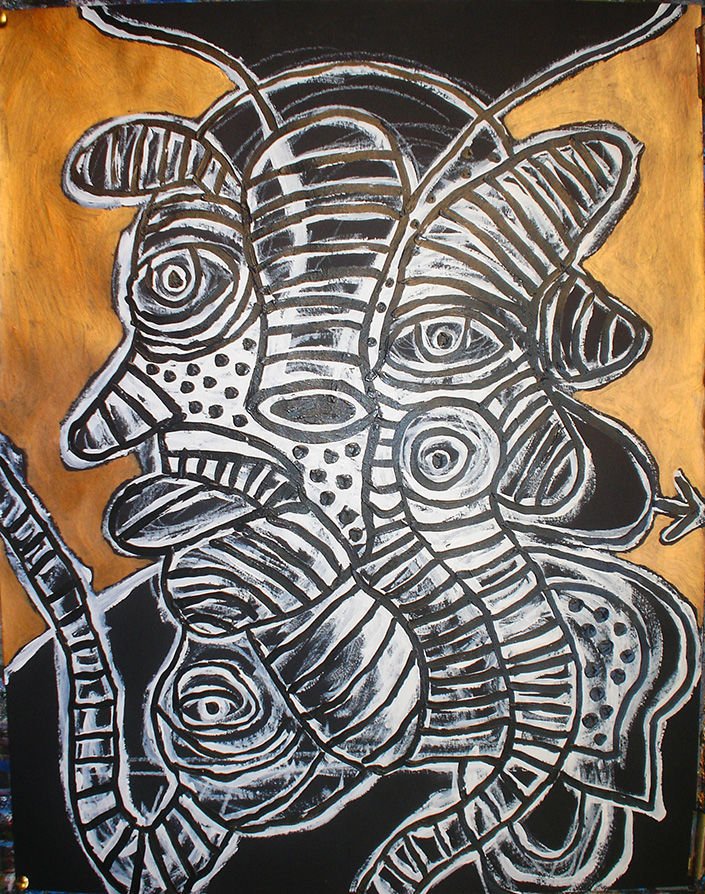
J CASTILLA-BAMBAREN "THE SIMBOLIC WEAVING"
"THE SIMBOLIC WEAVING"
In a creative path that was difficult to predict because, since his early beginning in 1980, this artist has been one of the most given to absorb elements of diverse artistic languages, assimilating them as alternative and simultaneous registers of one sensibility -his own-.
The latest paintings of Castilla-Bambaren evidence a depuration in a way of radical revision.
Until 1990, the synthesis of elements that characterized his paintings seemed ruled principally by the expressionistic spirit, because of the significative deformation of the beings that populated his works, and the evidently nervous application of the pictorial material and even in the chromatic tones clearly chosen for his creation of atmospheres. Apparently this expressionistic animation, sustained scenes of a narration with a plot impossible to decipher, that increased the sense of uneasiness in the observer. Later, the artist will discover that without abandoning the visual emblems developed in the process, he could simplify them until their transformation into concrete signs, even in a nature nearer to a recurrent motif, the serial pattern.
With these new simplicity CastiIIa -Bambaren opened different possibilities of condensation and expansion of his symbolic language. The effort of suggesting symbols instead of representing beings-characters in specific situations as an answer to narrative urge, opened him to the possibility that every canvas could be an integral symbol of painting, painting as an act of conceptual creation-in relation with life.
In that way his artistic proposal was reconfigured in the essential terms of his vision as a painter, in which violence -as a sign of human behavior - has a preponderant place.
Without leaving the acrylic as a medium of creation Castilla-Bambaren reaffirms the planimetric character of his pictorial work.
The vigorous impasto in the canvas, is now selectively applicated in areas alterning them with technical treatments so different: as the tingeing and dyeing of the canvas with diluted pigments, or the rubbed brushwork made with a used brush, or the incision. In certain cases, Castilla-Bambaren applies canvas fragments of different qualities and, creates textures in the surface generating in this way a great variety of stimulus, that construct an ambit of tactile sensations that are, at the same time, a new dimension of significance. It is possible that mostly all the narrative has been put aside. but the signs retain a clear fictitious profile that enchains and produces a total symbolic-visual structure, that would act as a transposition of the structure of the myth to the space of the pictorial creation, as an essential weaving of the sensibility of the artist.
The representations of signs like the skull, suggesting the notion death in life
and other suggestive forms of animal bodies or vegetal structures get in that way, the nature of a pictorial imperative over all others. The presence is coherent not by voluntarism, like the one that could be behind the will to make narrative in painting ,but as a concerted approach that Castilla-Bambaren proposes in each canvas.
The visual coherence of the whole is what convinces the observer that the ambiguous burden of existential roots in the painting has resonances that can be tracked to the nucleus of representation, contained in each sign.
The representation is often accompanied by divisions of the visual camp, that insinuates a possible symmetry -and by that way an order - that finally is not real. Certain pseudosymmetry resemble structures of popular religiosity like "the cross of the roads "(*) and their symbols of the passion. The division of camp allows a risky handle of color, maybe not too much in the violent contrast but in exploiting the vibration by the superimposition of layers, that always reveal the subjacent color around the elements surrounding them, like auras.
Its because of this, that the recent paintings of Castilla-Bambaren, suggest the conquest of equilibrium in relation with his early work… but the moment of apparent calm continues being unstable and even insinuates danger.
The artist handles color in function of its power to alert sensibility, (a remnant of recontextualized expressionism), the simplification of forms and the interconnection of them in the painted surface. (Just even because one does echoes of the others), suggest even with more strength the nudity of a man enfrenting the materialization of the myths of the specie...
JorgeVillacorta curator
Lima /Peru 1994
(*) " la cruz del camino "
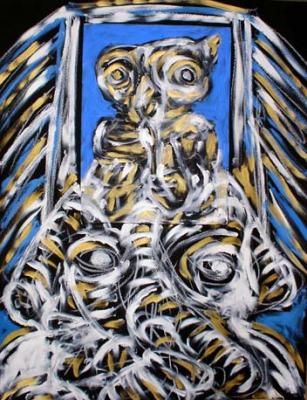
J CASTILLA-BAMBAREN
J.Castilla-Bambaren
Peruvian artist, he has exhibited representing his country in Biennals.
1991- XXI Biennal de Sao Paulo Brasil
1994- V Biennal de la Habana Cuba
1989- II Biennal de Cuenca Ecuador
1992- VIII Bienal Iberoamericana Mexico DF
In Perú he has been active showing his art since 1981.
The paintings of JCB are Figurative with mixed elements
of Abstraccion and Geometry.
He developed a personal style that has been influenced by the Prehispanic Art also the Art-Brut, German Expressionist Art, African Art, Oceanic Art and Informalism.
His art is a form of synthesis of rational and primitivist expressions.
2000 " Peruvian Phantom Forms", Barrister's Gallery - New Orleans , USA
2001 " Magie, Mythos, Metamorphose", Galerie Labyrintum – Germany 2003 “ Interne Feurer 1 “ – Galerie Labyrintum-Germany
2009 “Pinturas” Galeria Enlace Arte Contemporaneo Lima.Peru
1994 “JCB-Bleckkirche” – Iglesia mas antigua de Gelsenkirchen –Germany
2015 “Peruvian Metaphysicals” Barrister's Gallery - New Orleans , USA
2015 “Peru.Von den Inka bis zu Antonio Maro”- Galerie Langenohl-Germany Meinerzhagen
2016 “Equipaje Acompañado” Pinturas – Galeria 770 -Centro Cultural Ricardo Palma. Larco Miraflores - Peru

JCB - THE ART OF METAMORPHOSIS
Jorge Castilla-Bambarén – Peruvian artist who has exhibited his paintings at the following International Biennials: 1991 XXI Biennial of Sao Paulo, Brazil; 1994 V Biennial of Havana Cuba; 1989 II Biennial of Cuenca, Ecuador; and in 1992 the VIII Ibero-American Biennial of Mexico.
In Peru he has regularly presented solo exhibitions since 1981. Jorge Castilla-Bambarén’s painting is figurative and brings together elements of abstraction and geometry. His personal style of painting has nourished from several sources but perhaps the most obvious are: German Expressionism, Peruvian and Latin American Pre-Hispanic Art, “Art Brut” and African and Oceanic Art.
The compositional structures of his paintings also show an interesting assimilation of the artistic language of abstraction and informalism, this is coupled with a brushstroke that gives witness to the presence of Raw Art as another line of influence on his creative process. His is a form of expression that might be called a synthesis of rational languages with primitive expressionisms.
Opinions about his painting
“Castilla-Bambaren belongs to a select group of artists who contribute to imagine Latin America.”
Luis Felipe Noé – Artist
“excellent draftsmanship, a strange gift for composition and invention, and a confident use of color, seeking the exaltation of timbre to make more patent his fantastic scenes.” Alfonso Castrillón – Historian
“I admire the paintings of J. Castilla-Bambarén, firstly because they show an obvious mastery of the various aspects of painting: color, drawing, expression, space, line and composition.”
David Herskovitz – Artist
"There lies the strength of the—incisive, painful, violent and penetrating—work of JCB, whose honesty is coupled with the paucity of lines and colors, preferably to the coexisting dialectical opposition of chromatic effects imposed with the same force of the violence they represent.”
Mariano Querol – Psychiatrist
“To approach Castilla-Bambarén's painting involves entering a field of strange forces. It is an eclectic work that, out of the artist's uniqueness of vision, attains a remarkable cohesion and integrity.”
Jorge Villacorta – Curator
“These latest works of Castilla-Bambarén are the assertion of a personal and lonely ‘school.’ Defined by the force of color and the confrontational testimony of active figuration, his subject matters transit in deep harmony with singular iconic language.”
Silvio de Ferrari – Historian
“The truth is that there are artists who are far from being labeled, because their proposals go beyond the merely known and create universes of their own; as the Peruvian painter J. Castilla-Bambarén who puts forward a metamorphosis that figures and disfigures by way of catharsis.”
Luisa Fernanda Lindo – Curator and Poet
“J. Castilla-Bambarén remains a paradoxically solitary painter among his peers and a ‘cult figure’ for some for some young Peruvian painters, always attentive to the extensions of his personal bestiary and compositional daring, amidst which they emerge.”
Manuel Munive – Historian and Curator.
“JCB's painting is more complex and varied than many people assume. It has several registers. A playful side that for fear of ridicule is ignored by the scholarly and solemn; an overflowing expressive force, a serene intelligence that assumes as proper the most primitive forms of art from Africa, Oceania and America, freely, profoundly and originally.”
Lorenzo Osores – Writer and Artist.
Email : totem3xperu@yahoo.com
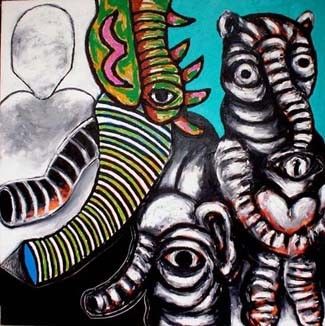
Reseñas y comentarios
